Deck 8: An Introduction to Metabolism
Question
Question
Question
Question
Question
Question
Question
Question
Question
Question
Question
Question
Question
Question
Question
Question
Question
Question
Question
Question
Question
Question
Question
Question
Question
Question
Question
Question
Question
Question
Question
Question
Question
Question
Question
Question
Question
Question
Question
Question
Question
Question
Question
Question
Question
Question
Question
Question
Question
Question
Question
Question
Question
Question
Question
Question
Question
Question
Question
Question
Question
Question
Question
Question
Question
Question
Question

Unlock Deck
Sign up to unlock the cards in this deck!
Unlock Deck
Unlock Deck
1/67
Play
Full screen (f)
Deck 8: An Introduction to Metabolism
1
Which of the following statements is an important consequence of the first law of thermodynamics for a living organism?
A) The energy content of an organism is constant.
B) An organism ultimately must obtain all of the necessary energy for life from its environment.
C) The entropy of an organism decreases with time as the organism grows in complexity.
D) Organisms grow by converting energy into organic matter.
A) The energy content of an organism is constant.
B) An organism ultimately must obtain all of the necessary energy for life from its environment.
C) The entropy of an organism decreases with time as the organism grows in complexity.
D) Organisms grow by converting energy into organic matter.
B
2
Chemical equilibrium is relatively rare in living cells because metabolic pathways are interconnected. Which of the following statements describes an example of a reaction that may be at chemical equilibrium in a cell?
A) an exergonic reaction in which the free energy at equilibrium is higher than the energy content of the reaction at any point away from equilibrium
B) an exergonic reaction in which the entropy change in the cell is precisely balanced by an opposite entropy change in the cell's surroundings
C) a chemical reaction in which neither the reactants nor the products are being produced or consumed in any metabolic pathway at that time in the cell
D) an endergonic reaction in an active metabolic pathway where the energy for that reaction is supplied only by heat from the environment
A) an exergonic reaction in which the free energy at equilibrium is higher than the energy content of the reaction at any point away from equilibrium
B) an exergonic reaction in which the entropy change in the cell is precisely balanced by an opposite entropy change in the cell's surroundings
C) a chemical reaction in which neither the reactants nor the products are being produced or consumed in any metabolic pathway at that time in the cell
D) an endergonic reaction in an active metabolic pathway where the energy for that reaction is supplied only by heat from the environment
C
3
Which of the following is an example of potential rather than kinetic energy?
A) water rushing over Niagara Falls
B) light flashes emitted by a firefly
C) a molecule of glucose
D) a crawling beetle foraging for food
A) water rushing over Niagara Falls
B) light flashes emitted by a firefly
C) a molecule of glucose
D) a crawling beetle foraging for food
C
4
Which of the following terms most precisely describes the cellular process of breaking down large molecules into smaller ones?
A) catabolism (catabolic pathways)
B) metabolism
C) anabolism (anabolic pathways)
D) dehydration
A) catabolism (catabolic pathways)
B) metabolism
C) anabolism (anabolic pathways)
D) dehydration

Unlock Deck
Unlock for access to all 67 flashcards in this deck.
Unlock Deck
k this deck
5
Which of the following statements about anabolic pathways is true?
A) They are usually spontaneous chemical reactions.
B) They consume energy to build up polymers from monomers.
C) They release energy by degrading polymers to monomers.
D) They decrease the entropy of the organism and its environment.
A) They are usually spontaneous chemical reactions.
B) They consume energy to build up polymers from monomers.
C) They release energy by degrading polymers to monomers.
D) They decrease the entropy of the organism and its environment.

Unlock Deck
Unlock for access to all 67 flashcards in this deck.
Unlock Deck
k this deck
6
The mathematical expression for the change in free energy of a system is ΔG = ΔH - TΔS. Which of the following statements is correct?
A) ΔS is the change in enthalpy, a measure of randomness.
B) ΔH is the change in entropy, the energy available to do work.
C) ΔG is the change in free energy.
D) T is the temperature in degrees Celsius.
A) ΔS is the change in enthalpy, a measure of randomness.
B) ΔH is the change in entropy, the energy available to do work.
C) ΔG is the change in free energy.
D) T is the temperature in degrees Celsius.

Unlock Deck
Unlock for access to all 67 flashcards in this deck.
Unlock Deck
k this deck
7
Which of the following statements is true for all exergonic reactions?
A) The products have more total energy than the reactants.
B) The reaction proceeds with a net release of free energy.
C) The reaction goes only in a forward direction: all reactants will be converted to products, but no products will be converted to reactants.
D) A net input of energy from the surroundings is required for the reactions to proceed.
A) The products have more total energy than the reactants.
B) The reaction proceeds with a net release of free energy.
C) The reaction goes only in a forward direction: all reactants will be converted to products, but no products will be converted to reactants.
D) A net input of energy from the surroundings is required for the reactions to proceed.

Unlock Deck
Unlock for access to all 67 flashcards in this deck.
Unlock Deck
k this deck
8
Living organisms increase in complexity as they grow, resulting in a decrease in the entropy of an organism. How does this relate to the second law of thermodynamics?
A) Living organisms do not obey the second law of thermodynamics, which states that the entropy of an organism increases with each energy transformation.
B) The decrease in entropy is associated with growth of an organism. As a consequence of growth, organisms cause a greater increase in entropy in their environment than the decrease in entropy associated with their increased complexity.
C) As a consequence of growth, the decrease in entropy of the organism is associated with a corresponding decrease in the entropy of the universe.
D) Living organisms are able to transform chemical energy into entropy.
A) Living organisms do not obey the second law of thermodynamics, which states that the entropy of an organism increases with each energy transformation.
B) The decrease in entropy is associated with growth of an organism. As a consequence of growth, organisms cause a greater increase in entropy in their environment than the decrease in entropy associated with their increased complexity.
C) As a consequence of growth, the decrease in entropy of the organism is associated with a corresponding decrease in the entropy of the universe.
D) Living organisms are able to transform chemical energy into entropy.

Unlock Deck
Unlock for access to all 67 flashcards in this deck.
Unlock Deck
k this deck
9
A decrease in entropy is associated with which type of reaction?
A) dehydration
B) catabolic
C) depolymerization
D) hydrolysis
A) dehydration
B) catabolic
C) depolymerization
D) hydrolysis

Unlock Deck
Unlock for access to all 67 flashcards in this deck.
Unlock Deck
k this deck
10
Which of the following statements describes the first law of thermodynamics?
A) Energy cannot be created or destroyed.
B) The entropy of the universe is decreasing.
C) The entropy of the universe is constant.
D) Energy cannot be transferred or transformed.
A) Energy cannot be created or destroyed.
B) The entropy of the universe is decreasing.
C) The entropy of the universe is constant.
D) Energy cannot be transferred or transformed.

Unlock Deck
Unlock for access to all 67 flashcards in this deck.
Unlock Deck
k this deck
11
Which of the following statements is consistent with the second law of thermodynamics?
A) A gain of free energy in a system is always associated with conversion of energy from one form to another.
B) A constant input of energy is required to maintain the high level of cellular organization.
C) Without an input of energy, the entropy of an organism would tend to decrease over time.
D) Every energy transformation performed by an organism decreases the entropy of the universe.
A) A gain of free energy in a system is always associated with conversion of energy from one form to another.
B) A constant input of energy is required to maintain the high level of cellular organization.
C) Without an input of energy, the entropy of an organism would tend to decrease over time.
D) Every energy transformation performed by an organism decreases the entropy of the universe.

Unlock Deck
Unlock for access to all 67 flashcards in this deck.
Unlock Deck
k this deck
12
The relationship between catabolism and anabolism is most similar to the relationship between which of the following pairs of terms?
A) exergonic; spontaneous
B) exergonic; endergonic
C) free energy; entropy
D) work; free energy
A) exergonic; spontaneous
B) exergonic; endergonic
C) free energy; entropy
D) work; free energy

Unlock Deck
Unlock for access to all 67 flashcards in this deck.
Unlock Deck
k this deck
13
Which of the following statements is true for a system at chemical equilibrium?
A) The system consumes energy at a steady rate.
B) The system releases energy at a steady rate.
C) The kinetic energy of the system is zero.
D) The system can do no work.
A) The system consumes energy at a steady rate.
B) The system releases energy at a steady rate.
C) The kinetic energy of the system is zero.
D) The system can do no work.

Unlock Deck
Unlock for access to all 67 flashcards in this deck.
Unlock Deck
k this deck
14
Why do hydrolysis reactions occur more readily in solution than dehydration reactions?
A) Hydrolysis reactions increase G, or Gibbs free energy of the system.
B) Hydrolysis reactions are endergonic and increase entropy of the system.
C) Hydrolysis reactions are exergonic and decrease entropy of the system.
D) Hydrolysis reactions are exergonic and increase entropy of the system.
A) Hydrolysis reactions increase G, or Gibbs free energy of the system.
B) Hydrolysis reactions are endergonic and increase entropy of the system.
C) Hydrolysis reactions are exergonic and decrease entropy of the system.
D) Hydrolysis reactions are exergonic and increase entropy of the system.

Unlock Deck
Unlock for access to all 67 flashcards in this deck.
Unlock Deck
k this deck
15
Which of the following statements about the evolution of life on Earth, from simple prokaryote-like cells to multicellular eukaryotic organisms, is true?
A) By resulting in such diversity and complexity of life, it is an exception to the second law of thermodynamics.
B) It has occurred in accordance with the laws of thermodynamics and resulted in a substantial increase in the entropy of the planet.
C) It has occurred in accordance with the laws of thermodynamics and resulted in a substantial increase in the total energy in the universe.
D) It has occurred in accordance with the laws of thermodynamics and resulted in a substantial decrease in the entropy of the planet.
A) By resulting in such diversity and complexity of life, it is an exception to the second law of thermodynamics.
B) It has occurred in accordance with the laws of thermodynamics and resulted in a substantial increase in the entropy of the planet.
C) It has occurred in accordance with the laws of thermodynamics and resulted in a substantial increase in the total energy in the universe.
D) It has occurred in accordance with the laws of thermodynamics and resulted in a substantial decrease in the entropy of the planet.

Unlock Deck
Unlock for access to all 67 flashcards in this deck.
Unlock Deck
k this deck
16
Which of the following statements is true of metabolism in its entirety in all organisms?
A) Metabolism depends on a constant supply of energy from food.
B) Metabolism uses all of an organism's resources.
C) Metabolism consists of all the energy transformation reactions in an organism.
D) Metabolism manages the increase of entropy in an organism.
A) Metabolism depends on a constant supply of energy from food.
B) Metabolism uses all of an organism's resources.
C) Metabolism consists of all the energy transformation reactions in an organism.
D) Metabolism manages the increase of entropy in an organism.

Unlock Deck
Unlock for access to all 67 flashcards in this deck.
Unlock Deck
k this deck
17
Which of the following statements is a logical consequence of the second law of thermodynamics?
A) If the entropy of a system increases, there must be a corresponding decrease in the entropy of the universe.
B) If the entropy of a system decreases, there must be a corresponding decrease in the entropy of the universe.
C) If there is an increase in the energy of a system, there must be a corresponding decrease in the energy of the rest of the universe.
D) Each chemical reaction in an organism must increase the total entropy of the universe.
A) If the entropy of a system increases, there must be a corresponding decrease in the entropy of the universe.
B) If the entropy of a system decreases, there must be a corresponding decrease in the entropy of the universe.
C) If there is an increase in the energy of a system, there must be a corresponding decrease in the energy of the rest of the universe.
D) Each chemical reaction in an organism must increase the total entropy of the universe.

Unlock Deck
Unlock for access to all 67 flashcards in this deck.
Unlock Deck
k this deck
18
A chemical reaction that has a positive ΔG is best described as ________.
A) endergonic
B) enthalpic
C) spontaneous
D) exergonic
A) endergonic
B) enthalpic
C) spontaneous
D) exergonic

Unlock Deck
Unlock for access to all 67 flashcards in this deck.
Unlock Deck
k this deck
19
Most cells cannot harness heat to perform work because ________.
A) heat is not a form of energy
B) temperature is usually uniform throughout a cell
C) heat can never be used to do work
D) heat must remain constant during work
A) heat is not a form of energy
B) temperature is usually uniform throughout a cell
C) heat can never be used to do work
D) heat must remain constant during work

Unlock Deck
Unlock for access to all 67 flashcards in this deck.
Unlock Deck
k this deck
20
Which of the following types of reactions would decrease the entropy within a cell?
A) anabolic reactions
B) hydrolysis
C) digestion
D) catabolic reactions
A) anabolic reactions
B) hydrolysis
C) digestion
D) catabolic reactions

Unlock Deck
Unlock for access to all 67 flashcards in this deck.
Unlock Deck
k this deck
21
When chemical, transport, or mechanical work is done by an organism, what happens to the heat generated?
A) It is used to power yet more cellular work.
B) It is captured to store energy as more ATP.
C) It is used to generate ADP from nucleotide precursors.
D) It is lost to the environment.
A) It is used to power yet more cellular work.
B) It is captured to store energy as more ATP.
C) It is used to generate ADP from nucleotide precursors.
D) It is lost to the environment.

Unlock Deck
Unlock for access to all 67 flashcards in this deck.
Unlock Deck
k this deck
22
Which of the following characteristics is most likely to be associated with an enzyme that catalyzes two different chemical reactions?
A) The enzyme contains α-helices and β-pleated sheets.
B) The enzyme is subject to competitive inhibition and allosteric regulation.
C) The enzyme is composed of at least two subunits.
D) Either the enzyme has two distinct active sites or the substrates involved in the two reactions have very similar structures.
A) The enzyme contains α-helices and β-pleated sheets.
B) The enzyme is subject to competitive inhibition and allosteric regulation.
C) The enzyme is composed of at least two subunits.
D) Either the enzyme has two distinct active sites or the substrates involved in the two reactions have very similar structures.

Unlock Deck
Unlock for access to all 67 flashcards in this deck.
Unlock Deck
k this deck
23
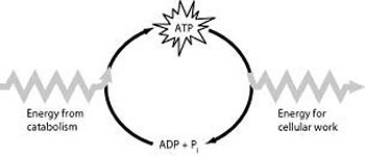
How do cells use the ATP cycle illustrated in the figure?
A) Cells use the cycle to recycle ADP and phosphate.
B) Cells use the cycle to recycle energy released by ATP hydrolysis.
C) Cells use the cycle to recycle ADP, phosphate, and the energy released by ATP hydrolysis.
D) Cells use the cycle primarily to generate heat.

Unlock Deck
Unlock for access to all 67 flashcards in this deck.
Unlock Deck
k this deck
24
How does a noncompetitive inhibitor decrease the rate of an enzyme-catalyzed reaction?
A) by binding to the active site of the enzyme, thus preventing binding of the normal substrate
B) by binding to an allosteric site, thus changing the shape of the active site of the enzyme
C) by decreasing the free-energy change of the reaction catalyzed by the enzyme
D) by binding to the substrate, thus changing its shape so that it no longer binds to the active site of the enzyme
A) by binding to the active site of the enzyme, thus preventing binding of the normal substrate
B) by binding to an allosteric site, thus changing the shape of the active site of the enzyme
C) by decreasing the free-energy change of the reaction catalyzed by the enzyme
D) by binding to the substrate, thus changing its shape so that it no longer binds to the active site of the enzyme

Unlock Deck
Unlock for access to all 67 flashcards in this deck.
Unlock Deck
k this deck
25
Zinc, an essential trace element for most organisms, is present in the active site of the enzyme carboxypeptidase. The zinc most likely functions as ________.
A) a noncompetitive inhibitor of the enzyme
B) an allosteric activator of the enzyme
C) a cofactor necessary for enzyme activity
D) a coenzyme derived from a vitamin
A) a noncompetitive inhibitor of the enzyme
B) an allosteric activator of the enzyme
C) a cofactor necessary for enzyme activity
D) a coenzyme derived from a vitamin

Unlock Deck
Unlock for access to all 67 flashcards in this deck.
Unlock Deck
k this deck
26
A number of systems for pumping ions across membranes are powered by ATP. Such ATP-powered pumps are often called ATPases, although they do not often hydrolyze ATP unless they are simultaneously transporting ions. Because small increases in calcium ions in the cytosol can trigger a number of different intracellular reactions, cells keep the cytosolic calcium concentration quite low under normal conditions, using ATP-powered calcium pumps. For example, muscle cells transport calcium from the cytosol into the membranous system called the sarcoplasmic reticulum (SR). If a resting muscle cell's cytosol has a free calcium ion concentration of 10⁻⁷ while the concentration in the SR is 10⁻², then how is the ATPase acting?
A) ATPase activity must be powering an inflow of calcium from the outside of the cell into the SR.
B) ATPase activity must be transferring ᵢ to the SR to enable this to occur.
ᵢ to the SR to enable this to occur.
C) ATPase activity must be pumping calcium from the cytosol to the SR against the concentration gradient.
D) ATPase activity must be opening a channel for the calcium ions to diffuse back into the SR along the concentration gradient.
A) ATPase activity must be powering an inflow of calcium from the outside of the cell into the SR.
B) ATPase activity must be transferring
 ᵢ to the SR to enable this to occur.
ᵢ to the SR to enable this to occur.C) ATPase activity must be pumping calcium from the cytosol to the SR against the concentration gradient.
D) ATPase activity must be opening a channel for the calcium ions to diffuse back into the SR along the concentration gradient.

Unlock Deck
Unlock for access to all 67 flashcards in this deck.
Unlock Deck
k this deck
27
Which of the following is true when comparing an uncatalyzed reaction to the same reaction with a catalyst?
A) The catalyzed reaction will be slower.
B) The catalyzed reaction will have the same ∆G.
C) The catalyzed reaction will have higher activation energy.
D) The catalyzed reaction will consume all of the catalyst.
A) The catalyzed reaction will be slower.
B) The catalyzed reaction will have the same ∆G.
C) The catalyzed reaction will have higher activation energy.
D) The catalyzed reaction will consume all of the catalyst.

Unlock Deck
Unlock for access to all 67 flashcards in this deck.
Unlock Deck
k this deck
28
Which of the following statements describes a key component of the induced fit hypothesis of enzyme catalysis?
A) Substrate binds to an allosteric site rather than to the active site of an enzyme.
B) Binding of an activator molecule changes the shape of the active site of an enzyme.
C) The conformation of the active site is determined by the tertiary or quaternary structure of the enzyme.
D) Binding of substrate to the active site changes the shape of the active site of an enzyme.
A) Substrate binds to an allosteric site rather than to the active site of an enzyme.
B) Binding of an activator molecule changes the shape of the active site of an enzyme.
C) The conformation of the active site is determined by the tertiary or quaternary structure of the enzyme.
D) Binding of substrate to the active site changes the shape of the active site of an enzyme.

Unlock Deck
Unlock for access to all 67 flashcards in this deck.
Unlock Deck
k this deck
29
Which of the following aspects of enzyme structure is best described by a clasping handshake analogy?
A) the specific manner in which an enzyme folds to form secondary and tertiary structures
B) the specific manner in which an enzyme interacts with water
C) the specific manner in which an enzyme binds substrate
D) the specific manner in which an enzyme is denatured by low pH
A) the specific manner in which an enzyme folds to form secondary and tertiary structures
B) the specific manner in which an enzyme interacts with water
C) the specific manner in which an enzyme binds substrate
D) the specific manner in which an enzyme is denatured by low pH

Unlock Deck
Unlock for access to all 67 flashcards in this deck.
Unlock Deck
k this deck
30
When ATP releases some energy, it also releases inorganic phosphate. What happens to the inorganic phosphate in the cell?
A) It is secreted as waste.
B) It is used only to regenerate more ATP.
C) It may be used to form a phosphorylated intermediate.
D) It enters the nucleus to be incorporated in a nucleotide.
A) It is secreted as waste.
B) It is used only to regenerate more ATP.
C) It may be used to form a phosphorylated intermediate.
D) It enters the nucleus to be incorporated in a nucleotide.

Unlock Deck
Unlock for access to all 67 flashcards in this deck.
Unlock Deck
k this deck
31
During a laboratory experiment, you discover that an enzyme-catalyzed reaction has a ∆G of -20 kcal/mol. If you double the amount of enzyme in the reaction, what will be the ∆G for the new reaction?
A) -40 kcal/mol
B) -20 kcal/mol
C) -10 kcal/mol
D) +20 kcal/mol
A) -40 kcal/mol
B) -20 kcal/mol
C) -10 kcal/mol
D) +20 kcal/mol

Unlock Deck
Unlock for access to all 67 flashcards in this deck.
Unlock Deck
k this deck
32
What is the name of the thermodynamic barrier that must be overcome before products are formed in a spontaneous reaction?
A) entropy
B) activation energy
C) the equilibrium point
D) free energy
A) entropy
B) activation energy
C) the equilibrium point
D) free energy

Unlock Deck
Unlock for access to all 67 flashcards in this deck.
Unlock Deck
k this deck
33
Which of the following molecules is most similar in structure to ATP?
A) a pentose sugar
B) a DNA nucleotide
C) an RNA nucleotide
D) an amino acid with three phosphate groups attached
A) a pentose sugar
B) a DNA nucleotide
C) an RNA nucleotide
D) an amino acid with three phosphate groups attached

Unlock Deck
Unlock for access to all 67 flashcards in this deck.
Unlock Deck
k this deck
34
Which of the following statements describes a central role that ATP plays in cellular metabolism?
A) Hydrolysis of ATP provides an input of free energy for exergonic reactions.
B) ATP provides energy coupling between exergonic and endergonic reactions.
C) Hydrolysis of the terminal phosphate group stores free energy that is used for cellular work.
D) Its terminal phosphate bond is stronger than most covalent bonds in other biological macromolecules.
A) Hydrolysis of ATP provides an input of free energy for exergonic reactions.
B) ATP provides energy coupling between exergonic and endergonic reactions.
C) Hydrolysis of the terminal phosphate group stores free energy that is used for cellular work.
D) Its terminal phosphate bond is stronger than most covalent bonds in other biological macromolecules.

Unlock Deck
Unlock for access to all 67 flashcards in this deck.
Unlock Deck
k this deck
35
Which of the following is a primary function of the active site of an enzyme?
A) It binds allosteric regulators of the enzyme.
B) It binds noncompetitive inhibitors of the enzyme.
C) It catalyzes the reaction associated with the enzyme.
D) It is activated by the presence of the end product of the metabolic pathway in which the enzyme is involved.
A) It binds allosteric regulators of the enzyme.
B) It binds noncompetitive inhibitors of the enzyme.
C) It catalyzes the reaction associated with the enzyme.
D) It is activated by the presence of the end product of the metabolic pathway in which the enzyme is involved.

Unlock Deck
Unlock for access to all 67 flashcards in this deck.
Unlock Deck
k this deck
36
Which of the following conditions may be overcome by increasing the substrate concentration in an enzymatic reaction with a fixed amount of enzyme?
A) the need for a coenzyme
B) allosteric inhibition
C) noncompetitive inhibition
D) competitive inhibition
A) the need for a coenzyme
B) allosteric inhibition
C) noncompetitive inhibition
D) competitive inhibition

Unlock Deck
Unlock for access to all 67 flashcards in this deck.
Unlock Deck
k this deck
37
Which of the following statements about enzyme function is true?
A) Enzyme function is generally increased if the three-dimensional structure or conformation of an enzyme is altered.
B) Enzyme function is independent of physical and chemical environmental factors such as pH and temperature.
C) Enzymes increase the rate of chemical reactions by lowering activation energy barriers.
D) Enzymes increase the rate of chemical reactions by providing activation energy to the substrate.
A) Enzyme function is generally increased if the three-dimensional structure or conformation of an enzyme is altered.
B) Enzyme function is independent of physical and chemical environmental factors such as pH and temperature.
C) Enzymes increase the rate of chemical reactions by lowering activation energy barriers.
D) Enzymes increase the rate of chemical reactions by providing activation energy to the substrate.

Unlock Deck
Unlock for access to all 67 flashcards in this deck.
Unlock Deck
k this deck
38
Which of the following statements describes a common characteristic of catabolic pathways?
A) They combine small molecules into larger, more energy-rich molecules.
B) They require energy from ATP hydrolysis to break down polymers into monomers.
C) They are endergonic and release energy that can be used for cellular work.
D) They are exergonic and provide energy that can be used to produce ATP from ADP and ᵢ.
ᵢ.
A) They combine small molecules into larger, more energy-rich molecules.
B) They require energy from ATP hydrolysis to break down polymers into monomers.
C) They are endergonic and release energy that can be used for cellular work.
D) They are exergonic and provide energy that can be used to produce ATP from ADP and
 ᵢ.
ᵢ.
Unlock Deck
Unlock for access to all 67 flashcards in this deck.
Unlock Deck
k this deck
39
Why is the ΔG of ATP hydrolysis in the cell about twice as great as the ΔG of ATP hydrolysis in a test tube under standard conditions?
A) A cell is an open system, whereas a test tube is a closed system.
B) ATP hydrolysis in a test tube releases more heat than ATP hydrolysis associated with cellular metabolism.
C) Reactant and product concentrations in the test tube are different from those in the cell.
D) ATP hydrolysis in cells is catalyzed by enzymes, whereas the reaction in a test tube occurs spontaneously.
A) A cell is an open system, whereas a test tube is a closed system.
B) ATP hydrolysis in a test tube releases more heat than ATP hydrolysis associated with cellular metabolism.
C) Reactant and product concentrations in the test tube are different from those in the cell.
D) ATP hydrolysis in cells is catalyzed by enzymes, whereas the reaction in a test tube occurs spontaneously.

Unlock Deck
Unlock for access to all 67 flashcards in this deck.
Unlock Deck
k this deck
40
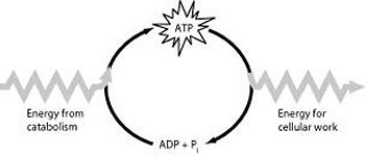
Which of the following is the most correct interpretation of the figure?
A) Energy from catabolism can be used directly for performing cellular work.
B) ADP +
 ᵢ are a set of molecules that store energy for catabolism.
ᵢ are a set of molecules that store energy for catabolism.C) ATP is a molecule that acts as an intermediary to store energy for cellular work.
D)
 ᵢ acts as a shuttle molecule to move energy from ATP to ADP.
ᵢ acts as a shuttle molecule to move energy from ATP to ADP.
Unlock Deck
Unlock for access to all 67 flashcards in this deck.
Unlock Deck
k this deck
41
Protein kinases are enzymes that transfer the terminal phosphate from ATP to an amino acid residue on the target protein. Many are located on the plasma membrane as integral membrane proteins or peripheral membrane proteins. What purpose may be served by their plasma membrane localization?
A) ATP is more abundant near the plasma membrane.
B) They can more readily encounter and phosphorylate other membrane proteins.
C) Membrane localization lowers the activation energy of the phosphorylation reaction.
D) They flip back and forth across the membrane to access target proteins on either side.
A) ATP is more abundant near the plasma membrane.
B) They can more readily encounter and phosphorylate other membrane proteins.
C) Membrane localization lowers the activation energy of the phosphorylation reaction.
D) They flip back and forth across the membrane to access target proteins on either side.

Unlock Deck
Unlock for access to all 67 flashcards in this deck.
Unlock Deck
k this deck
42
________ is a regulatory mechanism in which the end product of a metabolic pathway inhibits an enzyme that catalyzes an early step in the pathway.
A) Allosteric inhibition
B) Cooperative inhibition
C) Feedback inhibition
D) Metabolic inhibition
A) Allosteric inhibition
B) Cooperative inhibition
C) Feedback inhibition
D) Metabolic inhibition

Unlock Deck
Unlock for access to all 67 flashcards in this deck.
Unlock Deck
k this deck
43
Use the following information to answer the question below.
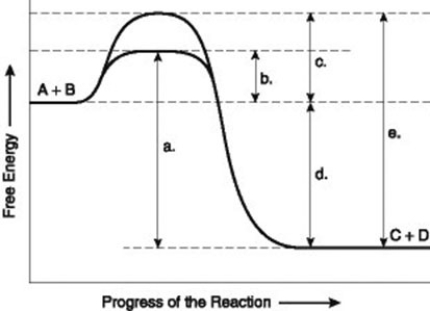
The figure illustrates the energy states associated with the reaction A + B ↔ C + D. Which of the following in the figure would be the same in either an enzyme-catalyzed or a noncatalyzed reaction?
A) a
B) b
C) c
D) d

The figure illustrates the energy states associated with the reaction A + B ↔ C + D. Which of the following in the figure would be the same in either an enzyme-catalyzed or a noncatalyzed reaction?
A) a
B) b
C) c
D) d

Unlock Deck
Unlock for access to all 67 flashcards in this deck.
Unlock Deck
k this deck
44
Characterization of the complete three-dimensional structure of a newly purified protein suggests that it catalyzes the breakdown of a large substrate. The protein consists of a single polypeptide chain. It has a large pocket that appears to be the binding site for the substrate and a smaller indentation that appears to be the binding site for a regulatory molecule. What do these structural observations suggest about the mechanism by which the activity of this protein is likely regulated?
A) It is probably an enzyme that is regulated by noncompetitive inhibition.
B) It is probably a multi-subunit enzyme that is regulated by allosteric regulation.
C) It is probably an enzyme that is regulated by competitive inhibition.
D) It is probably an enzyme that is regulated by cooperativity.
A) It is probably an enzyme that is regulated by noncompetitive inhibition.
B) It is probably a multi-subunit enzyme that is regulated by allosteric regulation.
C) It is probably an enzyme that is regulated by competitive inhibition.
D) It is probably an enzyme that is regulated by cooperativity.

Unlock Deck
Unlock for access to all 67 flashcards in this deck.
Unlock Deck
k this deck
45
Use the following information to answer the question below.
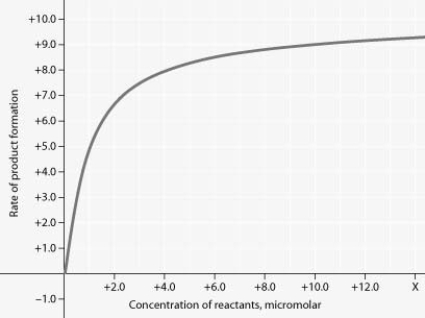
Rate of an enzyme-catalyzed reaction as a function of varying reactant concentration, with the concentration of enzyme constant
In the figure, why does the reaction rate plateau at higher reactant concentrations?
A) Feedback inhibition by product occurs at high reactant concentrations.
B) Most enzyme molecules are occupied by substrate at high reactant concentrations.
C) The reaction nears equilibrium at high reactant concentrations.
D) The rate of the reverse reaction increases at high reactant concentrations.

Rate of an enzyme-catalyzed reaction as a function of varying reactant concentration, with the concentration of enzyme constant
In the figure, why does the reaction rate plateau at higher reactant concentrations?
A) Feedback inhibition by product occurs at high reactant concentrations.
B) Most enzyme molecules are occupied by substrate at high reactant concentrations.
C) The reaction nears equilibrium at high reactant concentrations.
D) The rate of the reverse reaction increases at high reactant concentrations.

Unlock Deck
Unlock for access to all 67 flashcards in this deck.
Unlock Deck
k this deck
46
Which of the following statements describes an example of cooperativity associated with enzyme regulation?
A) binding of the end product of a metabolic pathway to the first enzyme in the pathway to inhibit the enzyme
B) one enzyme in a metabolic pathway passing its product to act as a substrate for the next enzyme in the pathway
C) binding a substrate to one subunit of a tetramer stimulates faster binding of substrate to each of the other three subunits
D) binding of an ATP molecule along with another substrate molecule in the active site of the enzyme
A) binding of the end product of a metabolic pathway to the first enzyme in the pathway to inhibit the enzyme
B) one enzyme in a metabolic pathway passing its product to act as a substrate for the next enzyme in the pathway
C) binding a substrate to one subunit of a tetramer stimulates faster binding of substrate to each of the other three subunits
D) binding of an ATP molecule along with another substrate molecule in the active site of the enzyme

Unlock Deck
Unlock for access to all 67 flashcards in this deck.
Unlock Deck
k this deck
47
Use the following information to answer the question below.
(a)
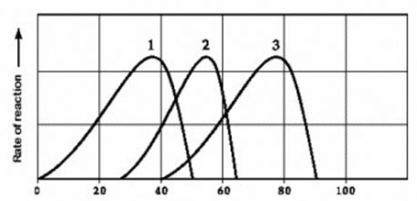
(b)
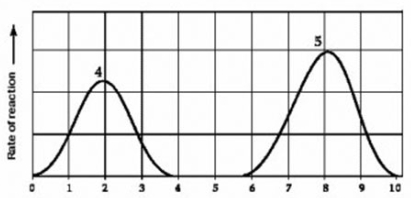
Activity of various enzymes at various temperatures (a)and at various pH (b)
Which temperature and pH profile curves on the graphs are most likely associated with an enzyme isolated from a human stomach where conditions are strongly acid?
A) curves 1 and 4
B) curves 1 and 5
C) curves 2 and 4
D) curves 3 and 4
(a)

(b)

Activity of various enzymes at various temperatures (a)and at various pH (b)
Which temperature and pH profile curves on the graphs are most likely associated with an enzyme isolated from a human stomach where conditions are strongly acid?
A) curves 1 and 4
B) curves 1 and 5
C) curves 2 and 4
D) curves 3 and 4

Unlock Deck
Unlock for access to all 67 flashcards in this deck.
Unlock Deck
k this deck
48
A series of enzymes catalyze the reactions in the metabolic pathway X → Y → Z → A. Product A binds to the enzyme that converts X to Y at a position remote from its active site. This binding decreases the activity of the enzyme. What is substance X?
A) an allosteric inhibitor
B) a substrate
C) an intermediate
D) the product
A) an allosteric inhibitor
B) a substrate
C) an intermediate
D) the product

Unlock Deck
Unlock for access to all 67 flashcards in this deck.
Unlock Deck
k this deck
49
In addition to activating or inhibiting enzymes through allosteric regulation, what other means does a cell use to control enzymatic activity?
A) localization of enzymes into specific organelles or membranes
B) secretion of enzymes out of the cell
C) assembly of enzymes into large aggregates
D) altering internal pH
A) localization of enzymes into specific organelles or membranes
B) secretion of enzymes out of the cell
C) assembly of enzymes into large aggregates
D) altering internal pH

Unlock Deck
Unlock for access to all 67 flashcards in this deck.
Unlock Deck
k this deck
50
In a metabolic pathway, succinate dehydrogenase catalyzes the conversion of succinate to fumarate. The reaction is inhibited by malonic acid, a substance that resembles succinate but cannot be acted upon by succinate dehydrogenase. Increasing the amount of succinate molecules to those of malonic acid reduces the inhibitory effect of malonic acid. Which of the following statements correctly describes the role played by molecules described in the reaction?
A) Succinate dehydrogenase is the enzyme, and fumarate is the substrate in the reaction.
B) Succinate dehydrogenase is the enzyme, and malonic acid is the substrate in the reaction.
C) Succinate is the substrate, and fumarate is the product in the reaction.
D) Fumarate is the product, and malonic acid is a noncompetitive inhibitor in the reaction.
A) Succinate dehydrogenase is the enzyme, and fumarate is the substrate in the reaction.
B) Succinate dehydrogenase is the enzyme, and malonic acid is the substrate in the reaction.
C) Succinate is the substrate, and fumarate is the product in the reaction.
D) Fumarate is the product, and malonic acid is a noncompetitive inhibitor in the reaction.

Unlock Deck
Unlock for access to all 67 flashcards in this deck.
Unlock Deck
k this deck
51
How might a change of one amino acid at a site, distant from the active site of an enzyme, alter the substrate specificity of an enzyme?
A) by changing the stability of the enzyme
B) by changing the three-dimensional conformation of the enzyme
C) by changing the optimum pH for the enzyme
D) by changing the binding site for a noncompetitive inhibitor
A) by changing the stability of the enzyme
B) by changing the three-dimensional conformation of the enzyme
C) by changing the optimum pH for the enzyme
D) by changing the binding site for a noncompetitive inhibitor

Unlock Deck
Unlock for access to all 67 flashcards in this deck.
Unlock Deck
k this deck
52
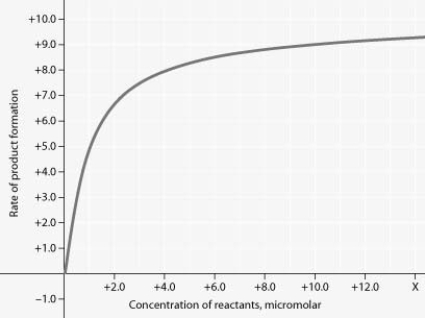
Rate of an enzyme-catalyzed reaction as a function of varying reactant concentration, with the concentration of enzyme constant.
For the enzyme-catalyzed reaction shown in the figure, if the initial reactant concentration is 1.0 micromolar, which of these treatments will cause the greatest increase in the rate of the reaction?
A) doubling the activation energy needed
B) cooling the reaction by 10°C
C) doubling the enzyme concentration
D) increasing the concentration of reactants to 10.0 micromolar, while reducing the concentration of enzyme by 1/2

Unlock Deck
Unlock for access to all 67 flashcards in this deck.
Unlock Deck
k this deck
53
Use the following information to answer the question below.
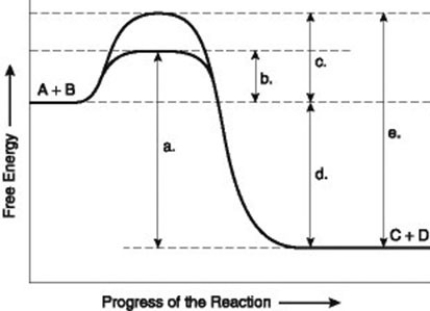
The figure illustrates the energy states associated with the reaction A + B ↔ C + D. Which of the following represents the activation energy required for the enzyme-catalyzed reaction in the figure?
A) a
B) b
C) c
D) d

The figure illustrates the energy states associated with the reaction A + B ↔ C + D. Which of the following represents the activation energy required for the enzyme-catalyzed reaction in the figure?
A) a
B) b
C) c
D) d

Unlock Deck
Unlock for access to all 67 flashcards in this deck.
Unlock Deck
k this deck
54
Use the following information to answer the question below.
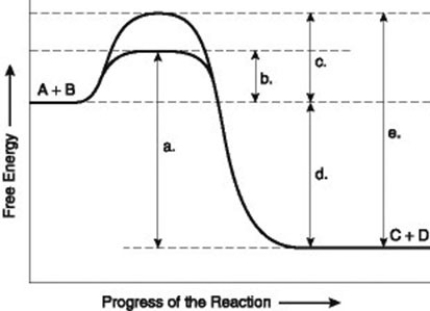
The figure illustrates the energy states associated with the reaction A + B ↔ C + D. Which of the following terms best describes the forward reaction in the figure?
A) endergonic, ∆G > 0
B) exergonic, ∆G < 0
C) endergonic, ∆G < 0
D) exergonic, ∆G > 0

The figure illustrates the energy states associated with the reaction A + B ↔ C + D. Which of the following terms best describes the forward reaction in the figure?
A) endergonic, ∆G > 0
B) exergonic, ∆G < 0
C) endergonic, ∆G < 0
D) exergonic, ∆G > 0

Unlock Deck
Unlock for access to all 67 flashcards in this deck.
Unlock Deck
k this deck
55
Use the following information to answer the question below.
(a)
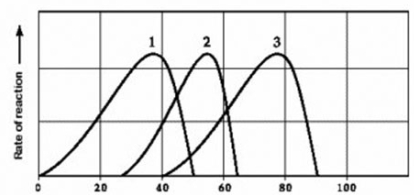
(b)

Activity of various enzymes at various temperatures (a)and at various pH (b)
Which curves on the graphs may represent the temperature and pH profiles of an enzyme taken from a bacterium that lives in a mildly alkaline hot springs at temperatures of 70°C or higher?
A) curves 1 and 5
B) curves 2 and 5
C) curves 3 and 4
D) curves 3 and 5
(a)

(b)

Activity of various enzymes at various temperatures (a)and at various pH (b)
Which curves on the graphs may represent the temperature and pH profiles of an enzyme taken from a bacterium that lives in a mildly alkaline hot springs at temperatures of 70°C or higher?
A) curves 1 and 5
B) curves 2 and 5
C) curves 3 and 4
D) curves 3 and 5

Unlock Deck
Unlock for access to all 67 flashcards in this deck.
Unlock Deck
k this deck
56
HIV is the virus that causes AIDS. In the mid-1990s, researchers discovered an enzyme in HIV called protease. Once the enzyme's structure was known, researchers began looking for drugs that would fit into the active site and block it. If this strategy for stopping HIV infections were successful, it would be an example of what phenomenon?
A) noncompetitive inhibition
B) denaturation
C) allosteric regulation
D) competitive inhibition
A) noncompetitive inhibition
B) denaturation
C) allosteric regulation
D) competitive inhibition

Unlock Deck
Unlock for access to all 67 flashcards in this deck.
Unlock Deck
k this deck
57
Use the following information to answer the question below.

The figure illustrates the energy states associated with the reaction A + B ↔ C + D. Which of the following represents the activation energy required for the non-enzyme-catalyzed reaction in the figure?
A) a
B) b
C) c
D) d

The figure illustrates the energy states associated with the reaction A + B ↔ C + D. Which of the following represents the activation energy required for the non-enzyme-catalyzed reaction in the figure?
A) a
B) b
C) c
D) d

Unlock Deck
Unlock for access to all 67 flashcards in this deck.
Unlock Deck
k this deck
58
Which of the following graphs most likely describes the effect of pH on the function of the enzyme catalase in human cells? Note: The x-axis is pH and the y-axis is enzyme activity.
A)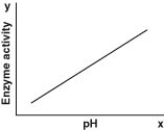
B)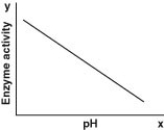
C)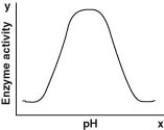
D)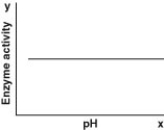
A)

B)

C)

D)


Unlock Deck
Unlock for access to all 67 flashcards in this deck.
Unlock Deck
k this deck
59
A series of enzymes catalyze the reactions in the metabolic pathway X → Y → Z → A. Product A binds to the enzyme that converts X to Y at a position remote from its active site. This binding decreases the activity of the enzyme. With respect to the enzyme that converts X to Y, substance A functions as ________.
A) an allosteric inhibitor
B) the substrate
C) an intermediate
D) a competitive inhibitor
A) an allosteric inhibitor
B) the substrate
C) an intermediate
D) a competitive inhibitor

Unlock Deck
Unlock for access to all 67 flashcards in this deck.
Unlock Deck
k this deck
60
In a metabolic pathway, succinate dehydrogenase catalyzes the conversion of succinate to fumarate. The reaction is inhibited by malonic acid, a substance that resembles succinate but cannot be acted upon by succinate dehydrogenase. Increasing the amount of succinate molecules to those of malonic acid reduces the inhibitory effect of malonic acid. What role does malonic acid play with respect to succinate dehydrogenase?
A) Malonic acid is a competitive inhibitor.
B) Malonic acid blocks the binding of fumarate.
C) Malonic acid is a noncompetitive inhibitor.
D) Malonic acid is an allosteric regulator.
A) Malonic acid is a competitive inhibitor.
B) Malonic acid blocks the binding of fumarate.
C) Malonic acid is a noncompetitive inhibitor.
D) Malonic acid is an allosteric regulator.

Unlock Deck
Unlock for access to all 67 flashcards in this deck.
Unlock Deck
k this deck
61
If an enzyme in solution is saturated with substrate, the most effective way to obtain a faster yield of products is to
A) add more of the enzyme.
B) heat the solution to 90°C.
C) add more substrate.
D) add a noncompetitive inhibitor.
A) add more of the enzyme.
B) heat the solution to 90°C.
C) add more substrate.
D) add a noncompetitive inhibitor.

Unlock Deck
Unlock for access to all 67 flashcards in this deck.
Unlock Deck
k this deck
62
If an enzyme is added to a solution where its substrate and product are in equilibrium, what will occur?
A) Additional substrate will be formed.
B) The reaction will change from endergonic to exergonic.
C) The free energy of the system will change.
D) Nothing; the reaction will stay at equilibrium.
A) Additional substrate will be formed.
B) The reaction will change from endergonic to exergonic.
C) The free energy of the system will change.
D) Nothing; the reaction will stay at equilibrium.

Unlock Deck
Unlock for access to all 67 flashcards in this deck.
Unlock Deck
k this deck
63
Most cells cannot harness heat to perform work because
A) heat does not involve a transfer of energy.
B) cells do not have much thermal energy; they are relatively cool.
C) temperature is usually uniform throughout a cell.
D) heat can never be used to do work.
A) heat does not involve a transfer of energy.
B) cells do not have much thermal energy; they are relatively cool.
C) temperature is usually uniform throughout a cell.
D) heat can never be used to do work.

Unlock Deck
Unlock for access to all 67 flashcards in this deck.
Unlock Deck
k this deck
64
Which of the following metabolic processes can occur without a net influx of energy from some other process?
A) ADP + → ATP + H₂O
→ ATP + H₂O
B) C₆H₁₂O₆ + 6O₂ → 6CO₂ + 6H₂O
C) 6CO₂ + 6H₂0 → C₆H₁₂O₆ + 6O₂
D) Amino acids → Protein
A) ADP +
 → ATP + H₂O
→ ATP + H₂OB) C₆H₁₂O₆ + 6O₂ → 6CO₂ + 6H₂O
C) 6CO₂ + 6H₂0 → C₆H₁₂O₆ + 6O₂
D) Amino acids → Protein

Unlock Deck
Unlock for access to all 67 flashcards in this deck.
Unlock Deck
k this deck
65
Some bacteria are metabolically active in hot springs because
A) they are able to maintain a lower internal temperature.
B) high temperatures make catalysis unnecessary.
C) their enzymes have high optimal temperatures.
D) their enzymes are completely insensitive to temperature.
A) they are able to maintain a lower internal temperature.
B) high temperatures make catalysis unnecessary.
C) their enzymes have high optimal temperatures.
D) their enzymes are completely insensitive to temperature.

Unlock Deck
Unlock for access to all 67 flashcards in this deck.
Unlock Deck
k this deck
66
Biological systems use free energy based on empirical data that all organisms require a constant energy input. The first law of thermodynamics states that energy can be neither created nor destroyed. For living organisms, which of the following statements is an important consequence of this first law?
A) The energy content of an organism is constant except for when its cells are dividing.
B) The organism must ultimately obtain all the necessary energy for life from its environment.
C) The entropy of an organism decreases with time as the organism grows in complexity.
D) Organisms are unable to transform energy from the different states in which it can exist.
A) The energy content of an organism is constant except for when its cells are dividing.
B) The organism must ultimately obtain all the necessary energy for life from its environment.
C) The entropy of an organism decreases with time as the organism grows in complexity.
D) Organisms are unable to transform energy from the different states in which it can exist.

Unlock Deck
Unlock for access to all 67 flashcards in this deck.
Unlock Deck
k this deck
67
Choose the pair of terms that correctly completes this sentence: Catabolism is to anabolism as ________ is to ________.
A) exergonic; spontaneous
B) exergonic; endergonic
C) free energy; entropy
D) work; energy
A) exergonic; spontaneous
B) exergonic; endergonic
C) free energy; entropy
D) work; energy

Unlock Deck
Unlock for access to all 67 flashcards in this deck.
Unlock Deck
k this deck



